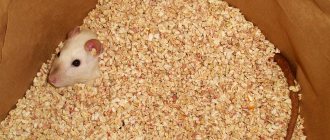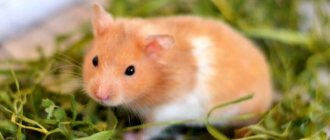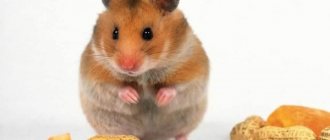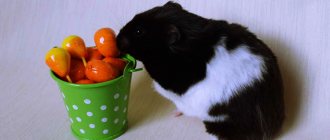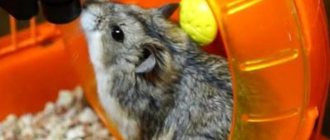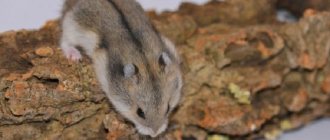A hamster is a cute pet. Its content has many advantages, but many who want to buy this animal are often faced with the choice of which hamster is better to get: Syrian or Djungarian? The fact is that these breeds are the most common in Russian homes. As representatives of the Khomyakov family, they are, of course, similar. But they also have several important differences, which may be decisive for the future owner when choosing a pet.
How do the carriers of these two breed qualities differ from each other, and which hamster is better to buy: Syrian or Djungarian, we will tell you in this article.
First, let's define the description of these two types of ornamental rodents.
Djungarian hamster. Appearance
This is a very miniature animal with a pointed muzzle and small ears. Its body weighs no more than 50 grams with a total length of no more than 10 cm. As a rule, it is covered with thick short fur, which in natural conditions is usually gray-brown in color with white patches. A blackish or dark gray stripe is expressed along the line of the spine - this is a common species characteristic for dzungarians. The belly, paws and inside of the animal's ears are usually white or light. The eyes are bulging and black.
The domestic Djungarian hamster differs in color from the wild one. There is a usual set of colors for domesticated animals: this is standard (gray-brown body with a white belly), sapphire color (bluish-gray, also with a light belly), pearl (whitish with gray splashes) and tangerine (cream with a red tint).
But you need to take into account that individuals of this species molt in winter and become almost white - because of this, and also because of their small size, the dzhungarika is sometimes called the Russian winter dwarf hamster. Nature has provided for the hamster to be invisible in the snow, because dwarfs do not hibernate and in winter conditions must also take care of food. However, it should be noted that in captivity, molting with color change rarely occurs.
Getting a hamster - disadvantages
The pet is very cute and fluffy , as all owners without exception can confirm. Small children are especially happy with the rodent; they like to watch the hamster run around the wheel with its paws, eat on both cheeks and sleep curled up in a ball. Thanks to the presence of a pet animal at home, parents can teach their baby that animals need to be looked after, that they need to be fed and cleaned up after them.
A 6-7 year old child can independently care for a pet, and this will help develop positive character traits in him. The baby will rejoice in his pet and try to care for him, showing himself as a responsible and caring person. It's easy to get the little ones excited by placing them in front of the hamster's cage and showing them what he's doing. During this time, while the baby is sitting by the cage, parents will be able to wash the dishes and even cook dinner.
Observing the life of an animal also calms parents. The hamster's chores help to distract from worries and problems, and in general, the realization that there is another living creature living in the house somehow warms and pleases the heart.
Keeping a hamster is not that difficult , the main thing is to remember what you can feed it and what you shouldn’t, as this can cause an upset stomach for your pet. The pet will hardly be able to cause any big trouble, the only thing is to make sure that the cage is always closed, because the hamster can run away somewhere, and due to its small size it will not be easy to find it.
Where does it live in nature?
Many people are interested in where and how the Djungarian (or Sungur) hamster lives in wild natural conditions. This interest is not just caused by curiosity: after all, in order to provide the best living conditions for an animal in captivity, it is important to know what the lifestyle of its wild ancestors was like.
In the Russian expanses, this type of hamster is very common, for example, in Khakassia, in some regions of Kazakhstan, and in the steppes of Southwestern Siberia. For its habitat, this rodent, due to its food preferences, chooses semi-deserts and steppe spaces where cereal herbaceous plants grow.
Djungarian hamsters are most active at night. They live in minks, which necessarily have several entrances and holes, as well as a nesting chamber.
The life expectancy of this rodent in the wild is short - no more than two, sometimes three years. At home, it usually increases, but only slightly.
Which hamster is better to get: characteristics of popular species
Today, many breeds of the rodents in question are known, but not all of them can be kept at home and allowed near children. Despite their small size, hamsters can be quite aggressive. In addition, they can in some cases cause allergies. Therefore, before buying a hamster, it is advisable to borrow an animal from friends for a few days and check the reaction of the family members.
The most popular rodents that can be kept at home include the following breeds:
- Djungarian is a common species. They have gray fur with a dark stripe on the spine and are classified as dwarf because they do not grow more than ten centimeters. Compared to other breeds, they are best tamed, but due to their small size, it is better not to have them in homes with children of kindergarten age - the nimble animal can slip out of children’s hands and get injured. Suitable for children from 10 years old.
- The Campbell breed looks practical in appearance, like the Djungarian, but their character is quite capricious and they bite. Individuals have a more yellow color and a paler stripe on the back.
- Roborovsky's hamsters are one of the smallest and rarest representatives (adult animals are no larger than 6 cm). A characteristic difference is socialization; they get along with same-sex relatives in the same cage. Kids will have fun watching a bunch of rodents, but they are unlikely to be able to pick them up - they are shy.
- Among Syrian hamsters, the royal hamster is the largest representative of the breed. Adults can be compared in size to a guinea pig. A distinctive feature is that they respond to the sound of their nickname. They are quite hardy in terms of physical health and life expectancy is 3–4 years. If you want to get a rodent for your home, then choose them, but remember - if handled roughly, they will show retaliatory aggression. The coat has different lengths - Angora with long hair and short-haired. Color - from golden to black. The only inconvenience is that they need a large cage. A 7-9 year old child can handle this animal on his own.
- The grasshopper (scorpion) hamster is a wild predator that eats even lizards or scorpions, and is solitary by nature. Therefore, zoologists do not recommend purchasing it for children.
- Siberian (White Russian Dwarf). It differs in that it changes the color of its coat depending on the time of year. It grows up to 10 centimeters and gets along well with people and is friendly.
- Eversmann's hamster is a wild field animal reaching a length of 16 centimeters. It is extremely rare in captivity and is asocial, so it should not be given to children.
Red-eyed albinos are found in every breed. You should not be afraid of them - the unusual color is explained by genetic changes. Such animals are healthy and no different from other “colored” relatives.
Content Features
Although many owners do not listen to this opinion, Djungarians should not be placed several times in one cage. However, as evidenced by the experience of keeping this species in captivity, it is best if there is only one animal in one cage.
Keeping a male and female together will result in offspring. If the animals are not further planted, their numbers will grow exponentially, and instinct will force the adults to eat their young. Usually this immediately causes understandable rejection among the owners, but here it should be understood that hamsters in their natural environment do not live in families, but in single individuals in each area, and captivity conditions cannot change this. Therefore, if a female hamster has offspring, they should be placed separately upon reaching a certain age (as soon as young hamsters are able to feed on their own).
It is also not recommended to keep two same-sex hamsters together: in this case, aggression towards each other is possible, both in females and males. In addition, living together in the same cage can cause stress in each of the inhabitants, and this will inevitably affect their owners as soon as they try to communicate with them.
It is best to feed Djungarian hamsters in captivity with special food.
It is worth noting that pet stores quite often sell animals of hybrid origin under the guise of a Djungarian hamster. Such individuals may have an unstable psyche and a tendency to various diseases, including diabetes. A conscientious breeder will always provide you with a pedigree upon request.
Now let’s look at materials about another, no less popular human companion animal.
Is it worth getting a hamster?
Pros of keeping a hamster
- You don't need a lot of space.
A hamster is not a Rottweiler. You don't have to buy a private home to own one. And even the size of the apartment does not matter. A hamster will need a tiny cozy corner in your home where you can install a cage. All!
- Easy care.
You don't need to walk your hamster twice a day. He doesn’t need to be bathed, combed, litter trained, and he doesn’t even need to be taught commands. It is enough to keep the cage clean and feed the baby correctly - this is the main care.
- No behavior problems.
A friend complains that the cat has torn off all the wallpaper in the house? Does your neighbor's dog bark loudly and keep you from sleeping at night? There will be no such problem with a hamster. This baby lives quietly in her cage, does not lay claim to your property and does not dream of “marking” your slippers. The worst thing a hamster can do to you is make a little noise at night. He is, after all, a nocturnal animal - he’s allowed!
- You can safely go on vacation.
Hamsters are unpretentious pets. They don't need your attention 24/7. You can easily leave for a couple of days on business or go on vacation, and your pet will have a great time alone!
Just buy a special automatic feeder and drinking bowl for your rodent, into which you can pour food and pour in plenty of water. And arrange with your relatives or friends to drop by for 5 minutes a couple of times a week: clean the cage and just check on the baby.
- Economical content.
Before the hamster comes home, you will have to spend a little money: buy a cage, a house, a drinking bowl, a feeder, food, a mineral stone, various toys and bedding. This is where the main expense item ends. In the future, you will only have to buy food and litter.
These are the main arguments in support of hamsters. And we didn’t even mention that they are just wildly cute and it’s interesting to watch their habits. You know this yourself!
Disadvantages of keeping hamsters
- The hamster is not human-oriented.
Hamsters are not human-oriented. They do not get much pleasure from communicating with us and get along just fine without it. Of course, a well-mannered, tamed hamster can, for the sake of decency, sit on your palm, climb onto your shoulder and allow itself to be petted. But at this moment he will most likely dream of escaping back into the cage and staying in the best company - himself!
A hamster is an animal that is best observed from the sidelines and minimally interfered with its life. If you dream of a tame pet who will be happy to interact with you, it is better to choose a guinea pig, degu or... a cat. “The Murderers” are champions in this matter!
- A hamster can bite.
Hamsters are often kept as a child's first pet. But there is a pitfall here: a cautious rodent can easily bite an obsessive owner. You can’t explain to him that you can’t offend children. And it’s difficult for children to restrain themselves from squeezing the cheeky baby. To avoid trouble, parents always need to be vigilant, regularly explain the rules for handling a rodent, and not leave children and pets unattended.
- A hamster is easily injured.
If you have a hamster at home, you need to turn into a superhero to protect this little one from all dangers. This is especially true for families with children. The child does not yet know how to measure his strength and may accidentally injure the baby.
Other pets are a separate issue. If you have a cat or dog, your hamster needs to be safely isolated from them. A metal cage is good, but it's not just about direct contact. If a cat and a dog constantly “circle” around the cage, guarding their little neighbor, such living will result in enormous stress for the hamster. Don't condemn the animal to this.
- A hamster can get lost in an apartment.
Of course, this is not as scary as if a dog or cat ran away. On the other hand, a huge number of dangers await a baby running around the apartment. He might eat something he shouldn’t, get stuck somewhere, something might fall on him... Perhaps we’ll stop with these horror stories.
The main thing is to try to prevent escape. And if you release your hamster from its cage, do not leave it unattended.
- The hamster makes noise at night.
Hamsters are nocturnal animals. Be prepared that they sleep during the day and rustle and rush around the cage at night. Of course, this is not as serious as the night howling or May songs at 5 am. But if you have sensitive sleep, nighttime hamster vigils can be a problem.
- Hamsters don't live long.
And this is perhaps the main disadvantage. Hamsters live from 1.5 to 4 years. It will be difficult to part with your beloved pet.
As a conclusion
If you decide to get a hamster, remember two main rules.
First. Hamsters should be liked by all members of your family who will live with the pet in the same house. If rodents are unpleasant to someone in the household, it is better to think about another pet. Moreover, a child is not worthy of a hamster, and you yourself do not like hamsters. The main concern for the rodent will still fall on you. You will have to force yourself to interact with him. And this will not bring happiness to either you or the furry baby.
And second. Hamsters are tiny, unpretentious pets. But they are by no means toys. Yes, a hamster does not require as much attention as a dog or cat. But he is also a member of the family. He also needs to be taken care of, he can also get sick and need your help, he also needs to be loved and taken care of. Then everything will be great!
Syrian hamster. Description
This representative of the Khomyakov family is larger than the Djungarian - together with the tail (1.5 cm), the body length of this rodent is 13 (in rare cases, up to 18) centimeters. In this case, the weight can reach 120-125 grams. Representatives of this species, also called Golden hamsters, are distinguished, respectively, by the golden or brownish color of their thick, soft fur. In the process of domestication and selection, the variability of coat color has expanded significantly: Syrian hamsters can be, in addition to the main colors, black and silver-white, as well as bicolor and even tortoiseshell.
A feature that is assigned to all hamsters in animal science, but is especially noticeable among Syrians, is the presence of cheek pouches. They are designed to transport food that the animal obtains while exploring the surroundings to its burrow. In addition, if there is a lot of food, this hamster also tends to store it in its bags. When full, the sacs sag from the cheeks to the very shoulders of the animal, which is why the name of this hamster is translated from Arabic as “Mr. Saddlebags.”
The remaining features that can be distinguished when comparing the Syrian hamster and the Djungarian hamster are the former’s prominent protruding ears, a slightly more elongated muzzle, and the absence of a dark dorsal stripe.
Coat types
Through the work of breeders, four separate subspecies of Syrian hamsters have been bred. These subspecies are distinguished by the following types of coat. The most common and common is the short-haired type. With such plush-like fur, different colors look best.
Long-haired Syrians have also been bred, another name for which is Angora. Males of this subspecies have a kind of “skirt” of long (8 to 10 cm) hair in the lower part of their body. However, the females look like ordinary Syrians, perhaps a little fluffier. In foreign pet stores, this variety is called “Teddy Bear hamster”.
The Satin or Satin Syrian hamster is distinguished by fur with a special, almost glossy sheen. This effect was achieved by breeding a new variety whose fur contained hollow hairs. However, individuals of Satin Syrians cannot be mated with each other, since this may result in the birth of animals with sparse hair or its complete absence.
Rex (or Curly) hamsters give the impression of being disheveled animals - the hairs in their lush outfit are slightly curled. In addition, rexes also have curled mustaches. This variety can be either short(-) or long-haired.
The last variety is represented by Hairless Syrian hamsters. They are characterized by a complete absence of hair. However, animals with such a fixed mutation sometimes still have a certain velvety appearance and even short “whiskers”.
Unfortunately, representatives of hairless Syrians are quite sickly, they require special care: in unfavorable temperature conditions, some owners even “dress” them. In addition, the life expectancy of a hairless Syrian hamster is half that of normal.
How to choose a hamster for a child: general tips
Hamsters are sold at any bird market. A large number of animals in one place causes the spread of infectious diseases and parasites. A cage standing in frost or draft leads to colds and hypothermia. Therefore, preference should be given to specialized stores where animals receive proper care.
The rodents in question are active at night, so to choose a healthy hamster, you should go to the pet store in the evening. A healthy rodent actively moves around the cage, runs on a wheel, digs in food and bedding, and does not limp. When a hamster is not sleeping, it should not show apathy or freeze in a stupor.
Pay attention to the age of the fluffy. Cubs up to a month old require special care - they need to be provided with enhanced heating and nutrition with special mixtures from a pipette.
After three months, the animal already has formed habits and is difficult to train. Therefore, the optimal age for choosing Syrian or other hamsters is 1 or 2 months.
Conduct a self-examination of the rodent. Take him in your arms - there should be no bald spots or lumps on the body. Signs of a health condition are:
- Smooth and shiny skin without bald spots.
- No nasal or eye discharge.
- Active behavior without obvious signs of overexcitation.
Yellow teeth are normal. This is explained by the characteristics of animal tooth enamel.
Where does it live and what does it eat?
Unlike the Djungarian hamster, the range of this animal is quite limited: it is found in Syrian, Turkish and Israeli semi-deserts. Due to human activities and the species' status as a pest, the Syrian hamster's habitat is in constant decline, and the species is now listed as endangered according to the International Union for Conservation of Nature (IUCN).
Like other hamsters, this one is most active at dusk or dawn. The Syrian is quite mobile: observations by zoologists have shown that during the “night shift” this animal is capable of running from three to eight kilometers. When clarifying which is better - the Djungarian or Syrian hamster - keep in mind that the Syrian is more active, and often this activity manifests itself in the evening, when he begins to run around on the wheel and explore his home in every possible way.
The life expectancy of the Syrian hamster is short, it is the same as that of the Djungarian hamster. This circumstance greatly upsets those who want to have this pet, who are thinking about which is better - a Syrian or a Djungarian hamster.
The diet of the Syrian is much wider: this animal is considered a practically omnivorous rodent, because it is able to feed not only on cereal seeds and all types of nuts (which, by the way, are prohibited for Djungarian hamsters), but also on small insects. Of the nuts, however, almonds and fruit seeds are contraindicated for Syrians.
Boy or girl? Character traits
If you don’t know what kind of rodent to get so that it gets along with kids, pay attention to gender. Unlike rats or other small pets, hamsters are not sterilized, so due to hormonal characteristics, the character and behavior of a male or female differs.
- Boys are larger than girls, they are calmer, more patient and affectionate, but they “mark” their territory, so an unpleasant odor if their home is not cleaned in a timely manner is guaranteed.
- Hamsters are more mobile and active, but at the same time they are also “hot-tempered”, especially during pregnancy or immediately after birth. They can injure the male, so they should be removed immediately after fertilization. In addition, females sometimes experience health problems related to the reproductive organs (endometritis).
Character, size, habits - all this can influence which hamster is best for a child.
Content
Like the Djungarian hamster, the Syrian is considered a territorially intolerant animal: the cubs should be separated from their mother as soon as they are four weeks old. Once the young animals reach eight weeks of age, in order to avoid conflicts, they should not be kept with each other either.
Remaining in the burrow, these hamsters behave like active housewives, sorting and sorting through food supplies, separating those that have spoiled.
In order for the hamster to move more, it is worth installing a special wheel in the cage. Well, all types of hamsters need wooden blocks or pieces of mineral stones to grind down their teeth.
Djungarian hamster - reviews about the breed
- + Leave a review
Leave a review Reset
Tweedledee
https://irecommend.ru/content/u-menya-takoe-chudo-zhivet
Advantages:
- funny
- unpretentious
- bringing positivity into the home
- clean
Flaws:
- live 1-2 years
Lives for more than a year, plump, smelling Goshik)))) I always remove his wheel in the evening, otherwise it will rattle at night. The smell is from the cage, be healthy! And he scatters sawdust around the cage))) But we love him, and it’s a pity to sell him, so we put up with all the pranks of our four-legged rodent... the little animal is unpretentious, very thrifty, once you start cleaning the cage, where a lot of grains sleep and peeled seeds lie for a rainy day! !! My hamster doesn’t bite (I’m very lucky with him), but his claws keep growing and I’m tired of cutting them off!
Hedgehog
https://irecommend.ru/content/ocharovatelnye-1
Advantages:
- funny
I don't like rats, mice and hamsters. But dzhungariki are something special. Small, beautiful, simply charming. True, you can’t tell from the noise at night that it is created by this little creature. The hamster is very active, quite clean, but the cage still needs to be washed at least as often as a large rat, the hamster itself does not smell. I had two of them, not immediately, but with a break of two years. They are basically similar in behavior. But their priorities in food are different. I fed them food plus fresh vegetables and fruits, but they can’t do everything, we need to take it into account. One did not eat seeds and grains. The second one chose only seeds and nuts from the food. They get used to the smell of the person who feeds them and calmly give themselves into his hands. But you still have to be careful when placing your hands in the cage; in surprise, he can bite, which is quite painful.
Sophia
My hamster has been living with me for a year now. Cons: CHEENS THE CAGE TERRIBLY LOUD. Probably the most important problem.
(For some reason, she is very angry, she constantly wants to bite me. She doesn’t seem to have done anything wrong, but she just keeps throwing herself. It’s funny until you put your hand in the cage. She can even bite off your finger.) Pros: they don’t smell. (I have a girl hamster)
Sofi_ya
https://irecommend.ru/content/3-khomyaka-i-vse-mashi
Advantages:
- active
- funny
- eat everything
- unpretentious
- bringing positivity into the home
Flaws:
- don't live long
- nocturnal active lifestyle
When I was still a child, like all children, I really dreamed of any creature))), but they didn’t allow me to have a dog or a cat - in the end they allowed me a hamster))) I chose a girl and named her MASHA))) There were so many emotions just not to put it into words - the best option for those who want a pet, but cannot afford it - there is a place for a hamster everywhere. Care is not difficult but a lot of joy!!! The MOST important thing is to take the females, they are not smelly like the males, of course, if you clean the cage during the time, tested from my own experience, after half a year I bought a friend for my Masha - and the next day I went to take it back, first of all, our MASHA was not happy and immediately bit a fellow tribesman, secondly, as soon as he felt the FEMALE, he began to emit a pungent odorous odor - it’s just terrible!!! So if you have a boy, you need to keep him in different cages. This is how our Masha lived for 2 years, it was very hard to say goodbye to her, she became like a member of the family, after that there were 2 more hamsters and also MASHA)) And they go to the toilet in a cage in one designated place, they are just smart))) We will definitely buy a hamster for my daughter when she grows up a little. Yes, one of the 3 hamsters was Angorka, but it’s a pity they don’t live long... only 2 years +/-
kitti24
https://otzovik.com/review_4047236.html
Advantages:
- Cool
Flaws:
- No
Djungarian hamster, the coolest little hamster. So funny and cool.
He eats little and is interesting to watch when he walks around the apartment and in his arms
Anonymous1456633
https://otzovik.com/review_5493349.html
Advantages:
- No
Flaws:
- horrible smell.
Many people write that there is no smell from the jungarik, but as soon as we brought it into the house, I realized that this was a lie. The obvious, unbearable smell of mice! I've kept a guinea pig before, but I've never had a decorative rat. He cannot sit in his arms, he is constantly running somewhere. Doesn't understand affection. Only unpleasant memories remain.
Tongerneldered
https://otzyv.expert/ne-ruchnoy-1616885
Advantages:
- cute
- Requires minimum cost and effort
Flaws:
- doesn't sit on hands
- hisses and bites painfully
- restless
- doesn't sleep at night
When our son turned 7 years old, he began to beg us for a pet to play with and take care of. We decided that the simplest option would be a small and harmless hamster.
When we came to the pet store, our eyes were drawn to the Djungarian hamster - he was the last one, a very cute little gray lump for 200 rubles. The sellers didn’t say anything bad about him, gave the necessary recommendations, and together with everything we needed, we bought this hamster.
At first, the hamster behaved very quietly, but did not sit in his arms, he always wanted to run away, and the son was upset, because he wanted a pet friend.
Over time, the hamster got used to it, constantly moves through the bars of the cage, climbs into the house and wheel, eats and drinks well, but he becomes most active at night, so it is almost impossible to sleep in the same room with him, he is constantly noisy.
Caring for this hamster is not very difficult, he is quite clean, and if you change everything for him regularly, he does not stink at all. We use sawdust, a package of which lasts for 1-2 months, as well as feed, which is quite a bit. He drinks water from a sippy cup and lasts for 1-2 weeks.
But in order to change the sawdust and clean the cage, the hamster needs to be pulled out of there, and this is more difficult - he won’t go into your arms, hisses and bites painfully. Therefore, we open the cage door and substitute a three-liter jar into which he eventually moves.
Therefore, I do not recommend purchasing such a hamster for lovers of tame pets, but for those who want to watch an animal in a cage, and at the same time put in little effort and expense, then it is quite suitable (if, moreover, you sleep soundly at night).
Anastasia201600
https://otzovik.com/review_2949967.html
Advantages:
- Lovely
- beautiful
Flaws:
- There are none, I advise
I used to have a Siberian and a Djungarian hamster, I recommend a Djungarian one. The Djungarian decorative hamster is something. He will replace your friend if necessary. Such hamsters are pleasant, living in cages, as there usually should be dirt and stench, for hamsters, but this is not the case with Djungarian hamsters. They also have beautiful black eyes *-* They are very mobile, they live for 3 years - that’s enough, the hamster will become your favorite animal, I advise
Alex441
https://otzovik.com/review_5906171.html
Advantages:
- Gives the child an understanding of what death and loss are.
Flaws:
- suicide
Perhaps the most short-lived pet (even worse than fish).
The high birth rate of hamsters is unfortunately compensated by a very short life, a predisposition to tumors and suicidal stupid behavior (well, what would you want from a rodent).
When choosing (you still can’t be dissuaded if you’re still reading this), use common sense. There is no need to take the runt that is being bullied by other hamsters - this is natural selection, his chances of life are even less than those of others.
The small animal is stupid, does not understand where it is and what is around it, which means, without any regret, excuse me, the owner will shit on his hands, on his shoulder, on his head, or wherever they put him.
I could check the cells for reliability. Night escapes from the cage are a matter of honor for the hamster.
The instinct of self-preservation is almost completely absent, sabotage is off the charts. It is quite normal for a hamster to climb up the cage to the very top and then jump off from there. Do not place it near the bed; if any rag objects come into the hamster’s reach, it will be very happy to let the object become part of the new “nest”. In general, it is better not to leave the cage in a room where people sleep.
When escaping, the hamster will happily hide behind the refrigerator, behind the closet, or in any other hard-to-reach places. Even if you can move the furniture, you most likely will not be able to do this - the hamster will not be frightened by a cabinet moving towards him. you will sit near the corner with a piece of cheese and pray that he has no other choice.
The most important thing is that when he dies (and he will die), take pity on your child, you have already made one mistake (taking this creature into the house), you don’t need to take a new one - he will end up exactly the same as the first.
Roundatier
https://otzyv.expert/lyubimec-moego-sina-478056
Advantages:
- Not whimsical
- soft and fluffy animal.
Flaws:
- Noisy at night
I've been wanting to get a pet for a long time! And I came up with the idea that it would be a Djungarian hamster. We named him "Grisha". He has been living with us for 2 weeks now. His son doesn’t leave him a single step, watching as he stuffs food into his cheeks.
I really like that he has no smell, he is not fussy, he eats special food. He constantly runs on a wheel. And buries itself in sawdust. Of course, he almost always sleeps during the day and runs around at night, and as luck would have it, the wheel began to creak and crack. So I take him to the kitchen for the night and close the door. It frolics coolly, buries itself in sawdust and runs under it. He'll block the ladder and bury it in sawdust, and then I'll wonder what he did with it.
Appreat
https://otzyv.expert/dzhunya-moy-malenkie-lyubimec-a-kogda-ih-dva-schastyu-prosto-net-predela-2173635
Advantages:
- cute
- fluffy
- friendly
- beautiful
- inexpensive
Flaws:
- make noise at night
- timid
Greetings, dear readers!
I want to tell you about my little pets - Djungarian hamsters. I have two of them, and they live together, because they are from the same litter and they can live together, but you need to make sure that they don’t fight. Mine are very friendly and never bite or fight!
Caring for them is as easy as shelling pears - feed them 2 times a day (in the morning and evening, they usually sleep during the day, so you don’t have to put a lot of food in the morning), clean the cage 1-2 times a week (it all depends on the degree of contamination), change the water (maybe in a day or two), and the most important thing is to give them your love and care!
They are very cool animals, it is very interesting to watch them, especially when they sleep outside the house! They are very fluffy, cute, but a little shy, so it is not advisable to make sudden movements when opening the cage or cleaning. They are also fragile, you can’t squeeze them too hard in your hands, much less drop them on the floor! This is fraught with disastrous consequences!
It won’t take a lot of money to maintain them either - food that lasts for a month (about 70-80 rubles), filler (preferably made from birch shavings - 40-50 rubles), vegetables and various delicacies (about 70 rubles) - in the end it doesn’t work out a very large amount!
They say that hamsters stink a lot. I'm willing to bet, because any creature stinks if you don't take care of it and clean up after it! Even you and I will smell if we don't wash for long enough! So, if you notice that there is a smell in the cage, get out of it more often - believe me, then there will definitely be no smell!
The cage should have: a house in which they spend quite a long time (they sleep, sometimes they carry food there), a drinking bowl with clean water, and most importantly, a running wheel, without which the hamster’s life will be bad! Without it, the hamster will get fat, and all this will lead to his early death, because he is very active, and the energy needs to be spent somewhere! And yes, be prepared for the fact that it will be a little noisy at night, but it’s all tolerable, and after a while you get used to it!
I definitely recommend these cute and fluffy animals - good luck to everyone! :)




